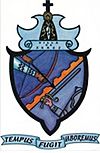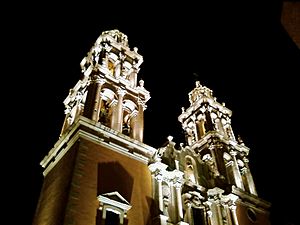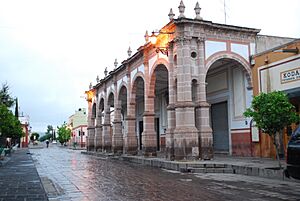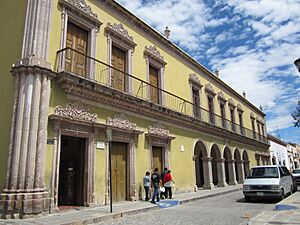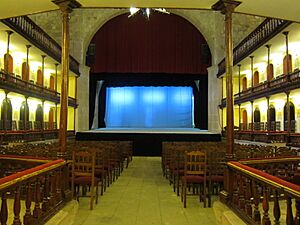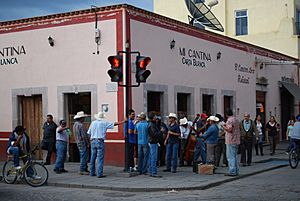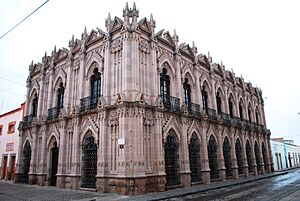Jerez de García Salinas facts for kids
Quick facts for kids
Jerez, Zacatecas
|
||
|---|---|---|
| Jerez de García Salinas | ||
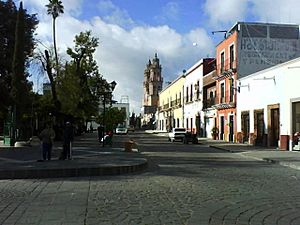
Calle del Santuario in Jerez
|
||
|
||
| Country | ||
| State | Zacatecas | |
| Municipality | Jerez | |
| Founded | 1569 | |
| Area | ||
| • Municipality | 587.26 km2 (226.74 sq mi) | |
| Elevation | 2,000 m (6,000 ft) | |
| Population
(2010)
|
||
| • Total | 57,610 | |
| • Demonym | Jerezano | |
| Time zone | UTC-6 (Central (US Central)) | |
| • Summer (DST) | UTC-5 (Central) | |
| Postal code |
99300
|
|
| Website | [1] | |
Jerez (Spanish: [xeˈɾes ðe ɣaɾˈsia saˈlinas]) is a town and municipality in the Mexican state of Zacatecas. It is officially called Jerez de García Salinas. This name honors a reformer from the 1800s.
The town of Jerez oversees 128 other smaller communities. These communities are mostly rural areas. They are well-known for growing fruit trees and making dairy products. Jerez was chosen as a Pueblo Mágico to help bring in more visitors. It is close to the state capital, Zacatecas. Visitors can find unique handcrafts, delicious traditional food, and interesting buildings here.
Contents
Exploring the Town of Jerez
The town of Jerez is about 57 kilometers from the state capital. It sits in a deep valley. This valley is surrounded by forests and fruit orchards.
The buildings and layout of Jerez are special. They are different from the state capital. The main spot in town is a central square called Jardín (garden) Rafael Páez. Long ago, this square was a market.
The square has a fancy iron fence around it. In the middle is a Moorish-style kiosk. It is made of metal with a sandstone base. On Sundays, many people gather here. Men play dominoes, and bands play local music called tamborazo. This music has a very special beat.
Important Buildings and Landmarks
On the south side of the square is the Portal Humboldt. It has two different styles of arches. One arch is in the Romance style, and the other is Arabic. To the north is the Portal Inguanzo. This building is from 1797. It used to be a private home. Today, it is a café and ice cream shop.
The Palacio Municipal, or town government building, is a former two-story mansion. It was built between 1730 and 1745. The front of the building is in the Baroque style. It is made of sandstone. The building was updated in the late 1900s. But its original front was carefully kept. Inside, there is a central courtyard with arches. Two staircases connect the floors. The main staircase is on the east side. The south staircase has a portrait of Francisco García Salinas.
The Sanctuary of Nuestra Señora de la Soledad (Our Lady of Solitude) was built in 1805. It stands where an old hospital for native people used to be. People say the architect was inspired by a cathedral in Santiago de Compostela. The style is Neoclassic. But it also has many Baroque parts. You can see these in the main gate. Inside, the main altar holds a statue of the Virgin Mary. This statue shows her after Jesus's death. The sanctuary also has beautifully carved confession booths and a pulpit. This local icon is called the 'General'. It is celebrated every year from January to February. It became very important during the Mexican Revolution. Soldiers honored her then.
The Edificio de la Torre (Torre Building) was built in 1894. Pantaleón de la Torre gave the land for it. He wanted to help education and culture in the municipality. At first, it was a school for girls. The building mixes Romance and Moorish styles. A stonemason named Dámaso Muñetón built it. He also built the north tower of the Zacatecas Cathedral. Today, the Edificio de la Torre is the Jerez Cultural Center. It also holds the municipal library. Next to the building is an alley for local handcrafts. You can find boots, wide cowboy hats, and embroidered leather belts (piteado) there.
Behind the Sanctuary of Nuestra Señora de la Soledad is Jardín (garden) Hidalgo. It faces the Hinojosa Theater. The theater was built between 1876 and 1890. It has a Moorish style with arches, windows, and railings. A local politician, José María Hinojosa, helped build it. The stage is under a sandstone arch. The seats are made of finely carved wood. For most of its history, carbide lamps lit the theater. A large old mirror from that time is still there. People believe the building was a barracks during the Mexican Revolution. Today, it is used for live shows. In the past, it was a movie theater, a place for parties, a library, and a school. Next to the theater is the Community Museum. It has many old items. These include carpentry tools, old archaeological pieces, and sewing machines. They show the area's rich history.
The Ramón López Velarde House Museum is on the street named after the town's most famous poet. This house was López Velarde's childhood home. It still has its original furniture from the 1800s. It also shows the poet's personal items. These include family photos and copies of his writings. One famous work is 'Suave Patria,' finished in 1921. It marked 100 years since the end of the Mexican War of Independence. The house became a museum in 1951. In 2009, it was updated. Now, you can hear recordings of López Velarde's poems there.
The Inmaculada Concepción parish is made of white sandstone. It was built in the 1700s. It has a simple single bell tower and a Baroque front. The arch of the main entrance has a papal crown and the keys of Saint Peter. Images of the Four Evangelists are nearby. The inside is Neoclassical. It has gold leaf on the altars and columns.

Some other interesting places are outside the town center. The Casa de Campesino is an 18th-century building. It used to be a home for groups helping rural farmers. Now, it is used for many things. The Chapel of Nuestra Señora de los Dolores (Our Lady of Sorrow) was built in the early 1800s. The Portal de las Palomas has several old-style bars. It faces a square called Plaza Tacuba. The Tizoc Bar is a bar and a store. It sells antiques and handmade items. The town's current market building has arches on two sides. This market sells fruits, vegetables, handmade goods, and prepared food.
Local Traditions and Festivals
Much of town life is still traditional. Businesses often close fully or partly on Saturdays. Charrería (Mexican rodeo) and bullfighting are very important to the area's culture. A big tradition is the Burning of Judas on Holy Saturday. This event starts the Feria de Primavera (spring festival). On this day, you can see charrería, cockfighting, and the running of the bulls. Town bar owners organize these events. About 70,000 visitors come for them. The Feria de Primavera is a non-religious fair. It is the oldest and most traditional fair of its kind in the state. It started in 1824. Local leaders wanted to show off the area's products. These included produce, yarn, minerals, and plaster. During Carnival, there is a unique tradition called La Jerezaditas. Children run among very young (one to two years old) bulls.
The Municipality of Jerez
The town of Jerez is the local government center for 128 other communities. The whole municipality covers an area of about 1,521 square kilometers. The Jerez municipality borders other municipalities like Fresnillo, Calera de Víctor Rosales, Susticacán, Zacatecas, Villanueva, and Valparaíso.
The town of Jerez is the largest community. Half of the municipality's people live there. Other important communities include Ermita de Guadalupe, Ermita de Los Correa, El Cargadero, and Santa Rita. These are mostly rural, agricultural towns. El Cargadero is known for having many people who have moved back from the United States.
The Hacienda de Ciénega used to belong to the Gordoa family. They were a very important family in Zacatecas in the 1800s. You can only see the hacienda from the outside. The main house and chapel have thick walls. They also have large, heavy wooden doors. The chapel is dedicated to Our Lady of Sorrows. The whole area includes a big plaza with trees.
History of Jerez
The town was named by its founders. They were Pedro Carrillo Dávila, Pedro Caldera, and Martín Morelos. They came from Jerez de la Frontera, Spain. The town in Zacatecas is named after their Spanish hometown. 'Jerez' comes from an Arabic word, 'scherich'. It means a lot of produce. They chose this name because the Zacatecas area was very fertile. It also looked like their hometown.
The town's full name was added in 1952. It honors Francisco García Salinas. He was a local politician. He helped share land, start textile mills, and open schools. The municipality also has an official seal. It shows an image of Our Lady of Solitude.
Early History and Spanish Arrival
Before the Spanish came, two native groups lived here. They were the Guachichils and the Zacatecos. The Zacatecos spoke a language like Nahuatl. They were farmers.
In the 1500s, Jerez was on a path used by Cristobal de Oñate. He was looking for gold. He found it southwest of Zacatecas city. Captain Pedro Carrillo Dávila was given land here. This was for his help in the Conquest. He was married to Sancha De Belmar. She was the daughter of Bernardino Vázquez De Tapia. Missionaries came next. They worked to convert the native people until the late 1500s. The first churches in town were for Ildefonsus and Saint Dominic.
People say the town was founded in 1536. It was meant to protect the road between Guadalajara and Zacatecas from native attacks. But official written records show the town was founded in 1570.
During the Mexican War of Independence, Spanish soldiers took control of the town in 1811. They started executing people they thought were helping the rebels. This made the town strongly support the independence movement.
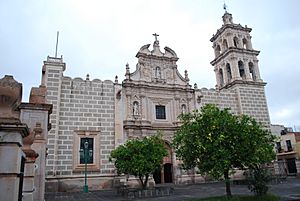
In 1898, Jerez had several businesses. There were mining companies like La Soledad and Palmira. It also had two printing shops and a brewery. There were two companies that made carriages. Antonio Castellanos owned the only hotel. There were two silversmiths and three flour mills.
Growth and Revolution
In the 1800s, the town and its area grew. This was mostly because of farming. The first part of the Sanctuary of Our Lady of Solitude was finished in 1819. The state's Instituto Literario was started here. But it moved to Zacatecas city in 1837. The Hinojosa Theater was built in 1869. By the late 1800s and early 1900s, about 12,000 people lived here. The large farms (haciendas) near Jerez were very productive. But no railroads were built here. Goods had to be sent to Zacatecas city. Two famous artists from Jerez were born then. They were Ramón López Velarde (1888) and Máximo Pérez Torres (1899).
Just before the Mexican Revolution, something important happened on September 15, 1910. This was the day of the traditional Grito de Dolores. It celebrates the start of the War of Independence. But instead of shouting "Viva México," people shouted "Viva Madero!" This showed support for the politician who opposed the leader, Porfirio Díaz. This caused problems in the days that followed.
Rebels against Díaz in the area heard about this. On September 19, they attacked and killed federal troops. They also set fire to the Hinojosa Theater and the town hall. This fire destroyed many old town records. Many people had to leave as things got worse.
Pánfilo Natera's troops officially took over the city in 1913. The town survived the Revolution. But its recovery was slow because of the Cristero War that followed. One battle of this war happened near Santa Fe. The Cristeros won that battle.
In 1952, the town's name changed to "Jerez de García Salinas." The municipality kept the name "Jerez." The statue of the Virgen de la Soledad was restored in 1979. The new town hall opened in 1983. The Mexican President Miguel de la Madrid was there. In 2001, the municipality elected its first president who was not from the Partido Revolucionario Institucional (PRI). This was the first time since the Mexican Revolution.
Geography and Nature
The land in Jerez is mostly flat. There are some small hills. But in the north, you can find the Sierra de Jerez mountains. The highest point is about 2,750 meters above sea level. About 20 kilometers west of town is the Sierra de Los Cardos. This area has most of the municipality's natural beauty. It has rough land perfect for camping, mountain biking, rock climbing, and rappelling. Many streams flow during the rainy season.
The main water source is the Jerez River. It flows from north to south through the municipality. This river and several streams have five dams. These include Encino Mocho and Tesorero. The Cargadero and Tesorero dams are popular for sports fishing. Also, 158 wells provide drinking water. They also help with farming needs.
Climate in Jerez
The climate here is mild and dry. It rains about 500 millimeters each year. Most of the rain falls in the summer. The average temperature for the year is 16 degrees Celsius.
| Climate data for Jerez de García Salinas (1951–2010) | |||||||||||||
|---|---|---|---|---|---|---|---|---|---|---|---|---|---|
| Month | Jan | Feb | Mar | Apr | May | Jun | Jul | Aug | Sep | Oct | Nov | Dec | Year |
| Record high °C (°F) | 29.0 (84.2) |
32.0 (89.6) |
32.0 (89.6) |
36.0 (96.8) |
36.0 (96.8) |
37.0 (98.6) |
34.0 (93.2) |
33.0 (91.4) |
39.0 (102.2) |
33.0 (91.4) |
32.0 (89.6) |
29.0 (84.2) |
39.0 (102.2) |
| Mean daily maximum °C (°F) | 22.7 (72.9) |
24.0 (75.2) |
26.3 (79.3) |
29.0 (84.2) |
30.6 (87.1) |
29.9 (85.8) |
27.8 (82.0) |
27.6 (81.7) |
26.9 (80.4) |
26.3 (79.3) |
25.2 (77.4) |
22.9 (73.2) |
26.6 (79.9) |
| Daily mean °C (°F) | 12.7 (54.9) |
14.2 (57.6) |
16.0 (60.8) |
18.5 (65.3) |
20.8 (69.4) |
21.8 (71.2) |
20.8 (69.4) |
20.6 (69.1) |
19.8 (67.6) |
17.9 (64.2) |
15.5 (59.9) |
13.5 (56.3) |
17.7 (63.9) |
| Mean daily minimum °C (°F) | 2.8 (37.0) |
4.4 (39.9) |
5.7 (42.3) |
8.1 (46.6) |
11.0 (51.8) |
13.8 (56.8) |
13.7 (56.7) |
13.6 (56.5) |
12.7 (54.9) |
9.4 (48.9) |
5.8 (42.4) |
4.0 (39.2) |
8.8 (47.8) |
| Record low °C (°F) | −7.0 (19.4) |
−4.0 (24.8) |
−3.0 (26.6) |
−2.0 (28.4) |
3.5 (38.3) |
8.0 (46.4) |
10.0 (50.0) |
8.5 (47.3) |
4.0 (39.2) |
1.5 (34.7) |
−3.0 (26.6) |
−5.0 (23.0) |
−7.0 (19.4) |
| Average precipitation mm (inches) | 22.9 (0.90) |
15.9 (0.63) |
1.2 (0.05) |
2.6 (0.10) |
13.7 (0.54) |
70.1 (2.76) |
125.3 (4.93) |
116.0 (4.57) |
76.9 (3.03) |
29.0 (1.14) |
10.0 (0.39) |
12.1 (0.48) |
495.7 (19.52) |
| Average precipitation days (≥ 0.1 mm) | 2.2 | 1.4 | 0.4 | 0.5 | 3.1 | 9.3 | 12.8 | 12.4 | 8.7 | 4.2 | 2.0 | 2.2 | 59.2 |
| Source: Servicio Meteorologico Nacional | |||||||||||||
Plants and Animals of Jerez
The municipality has many types of wild plants. These include holm oak trees, pine trees, mesquite, huizache, nopal cactus, and different kinds of grasses. The local wild animals are mostly mammals. You can find rabbits, pumas, javelinas, wildcats, coyotes, deer, and raccoons. There are also many types of birds and reptiles.
Economy and Tourism
The municipality's economy mainly depends on farming. Farmers grow crops like corn, beans, and animal feed. The area is famous for its fruit orchards. They grow peaches, apples, and apricots. About half of this fruit comes from around the town of El Cargadero. There is also a big dairy industry that makes products like cheese.
Another important traditional activity is making crafts. People make leather items like saddles, boots, and especially belts. These belts are often embroidered with maguey fiber (piteado). Also, artists make gold and silver jewelry. They are known for gold filigree half-moon earrings. People also work with iron, stone, and pottery.
Jerez is close to the capital city. But most tourists in the state have not discovered it yet. To attract more visitors, Jerez joined the federal government's Pueblos Mágicos program. This program highlights its traditional buildings, cultural traditions, and rich food. Some local dishes include mole jerezano (a mole sauce with almonds), carne de puerco en salsa verde, carne adobada, carne deshebrada (shredded beef), asado de boda, brocheta jerezana (beef tips with sausage, bacon, onion, tomatoes, and poblano chili peppers), burritos, and fruit ices.
Visitors can also enjoy places like the Las Margaritas water park. The El Manantial Eco-Tourism Center offers camping, hiking, rappelling, and cabins. It's a great place for outdoor fun.
Images for kids
See also
 In Spanish: Jerez de García Salinas para niños
In Spanish: Jerez de García Salinas para niños


